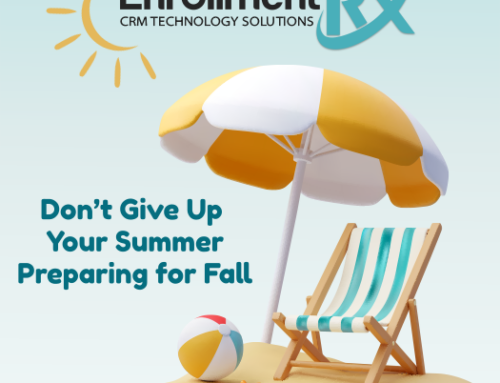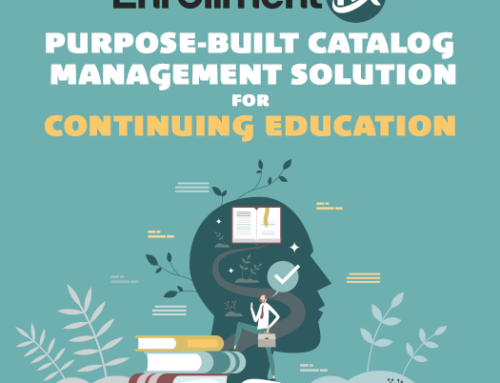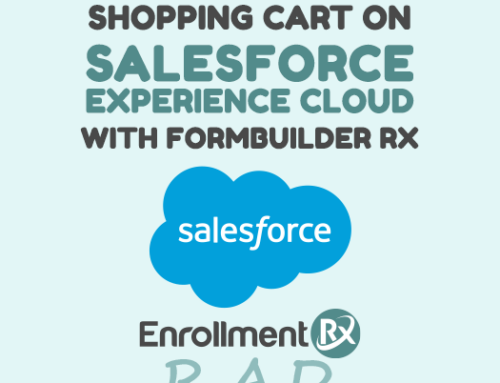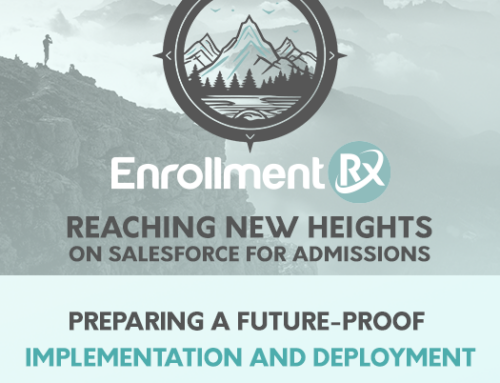My first job after college was as an Admission Counselor and Recruiter. Like many young people in the profession, I started working in the Admission and Visit Office as a student where I was introduced to college admission. It wasn’t a career path that I considered prior to college, but I found the environment engaging and the work enjoyable. After graduation, I was hired as a full-time Admission Counselor. I was assigned a territory, provided with a list of high schools, blasted with information on academic programs, scholarships, and application processes, and then I was set loose to recruit students only a few years younger than myself.
My undergraduate work was in humanities, so at the time I had no background in business practices or IT. Shortly after starting this job full-time, the office I was working in implemented a new CRM for managing the recruitment and admission cycles. The platform was called Salesforce, and the admission and recruitment tools were called Enrollment Rx. I was not aware that Salesforce was a juggernaut of a technology company used by startups and Fortune 100s alike, nor had I ever heard the term CRM. I did, however, recognize that there were broken processes in place and that we were using dated software to manage our interactions with students from the prospect stage to enrolled. Within a few months, our office was well on its way to ironing out these processes on the new CRM platform. I became a CRM “power user” by continuing these improvements, as well as acting as a technical resource for other counselors and recruiters on my team.
I can’t speak for all admission counselors, but I can say that personally, I did not like to think of myself as a salesperson. In my mind, there was a negative stigma to “selling” higher education, especially when I was recruiting for my alma mater. I began working on my MBA around this time when I was introduced to accounting concepts such as operating costs and sales pipelines. These were subjects that I had previously been aware of, but never applied them to my life or job. I began to recognize the business side of higher education and the value that a proper CRM could add to the life of an admission counselor.
Below are five ways that an exceptional CRM can make college recruiting easier for the boots-on-the-ground admission counselor.
1. Tracking interactions: This is sometimes referred to as a contact or activity history. There should be a record of every interaction that a student has with your organization and vice versa, regardless of whether it is initiated by the institution or the student. Every interaction that a student’s parents or their high school counselor has with your organization should also be tracked. This includes every email sent to and from a student, every phone call including notes as to what was discussed, and every event or activity that a student participated in.
The idea of activity tracking may seem obvious. After all, that is the crux of a “customer relationship management” system. However, when put into practice, it allows for a personal touch, continuity from the point of view of the student and their parents, and it provides clarity relating to the student’s journey from inquiry to enrollment.
After a year or so of using a real CRM, my organization was tracking most of what I previously mentioned. When a student would call me, I could look at their record and see that they just received an email reminding them to submit a letter of recommendation for a scholarship application (something we were also now able to automate). While managing a queue phone, I would sometimes have to speak to a student that wasn’t assigned to me. Rather than having them explain their extensive background to me, I had a detailed account of what was previously discussed with their assigned admission counselor.
Tracking these interactions was not reinventing the wheel, but the impact was noticeable by our staff, our students, and their parents. So long as I had access to the CRM, I was never going into a situation blind. Students, and especially parents, were impressed by their interaction with our university because we knew who they were, what their previous engagements were with us, and we could pick right back up with every new interaction.
2. Reporting: Forecasts, analytics, and reporting can be scary words for someone with no background in business or technology. Before CRM systems like Salesforce and Enrollment Rx, an organization might need a report writer who could pull information from a database in order to run reports. This data could be stored in multiple disparate locations or spreadsheets, which can get messy. An effective CRM empowers anyone who can point, click, drag, and drop to create their own reports and keep them organized.
Reporting capability quickly became my favorite feature of Salesforce and Enrollment Rx. There were simple reports that everyone at my level could use: a report of the total number of applications, a report on students who had incomplete applications, reports of students based on geography, and more. As I became more comfortable with building reports, the reports got more specific and more useful.
I started using reports during recruiting trips. With a few minutes of report building, I could run a single report applicable to a specific high school. Prior to visiting a feeder school, I would run a report that would show which students I had from that school, what stage of the application process they were in, and even what checklist items they were missing to complete their application. Reports could be made even more specific based on any information in the CRM. For example, I had the ability to remind students from a specific school who are interested in Engineering that there was an Engineering scholarship they could apply for.
I started using reports for everything from recruitment trips, to tracking progress toward goals, to understanding how I was succeeding and where I could do better. I had no background in report writing, and I didn’t know what a database administrator was. But, after a few months, I could create specific, complex, and useful reports.
3. Dashboards: These go hand-in-hand with reports; dashboards are just prettier. Salesforce and Enrollment Rx gave our team the ability to display any information from a report in an attractive, easy-to-understand format that could be created with mouse clicks and drag-and-drop functionality. This was particularly helpful in visualizing and tracking my work. I could set my CRM home screen to show the dashboards most pertinent to that time of year. There were times when I needed to make dozens, or even hundreds, of phone calls and my dashboard showed how I was progressing. As we got close to application or decision deadlines, I could use dashboards that showed students at different phases of our funnel. This included number of applications, number of admits, and number of deposits.
For managers and administrators, the dashboard functionality was enormously useful for tracking their individual team performance and how the admission office was functioning overall. My boss could set up their dashboards to see the performance of each of the counselors that reported to them. Higher leadership positions, or those who did not spend as much time in the CRM, could have weekly or daily dashboards emailed to themselves automatically. These could show overall year-over-year performance or in specific markets, demographics, and more.
Just like reporting, Salesforce and Enrollment Rx made creating and viewing dashboards simple and user-friendly.
4. Travel and Account Management: Every college does recruitment and territory assignment a little differently. Geography, high school type, or even round robin assignment can all go into what makes up a recruiter’s territory. I would recruit a majority of my university’s feeder schools, which were mostly local. High schools in my territory would enroll a large number of students at my university, with a number of them showing interest by attending events or submitting an application, even if we were not their final decision.
With an effective CRM, I was able to start treating high schools like accounts with associated students, high school counselors, administrators, and other information. As I planned travel for the fall, I could look at a high school and see who I need to contact to set up the visit, what days and times they preferred, and even information on where to park and check in. Then, without leaving the CRM, I could view all prospective students I had from that school and what stage of the admission funnel they were at. Because I was recruiting locally, I could sometimes bring student workers from our office as I visited their alma mater. It was extremely effective bringing along an alum to share their experience with a room full of high school students who were considering my university.
Because college admission often has turnover among recruiting staff, having all of this information in one place is crucial. A recruiter moving on or changing territory was no longer a hassle. They could see and replicate their incumbent’s recruitment plans from years past and know everything they need about the high schools in their new territory.
5. Application Review: Salesforce and Enrollment Rx made application review easier. Before, I was looking at multiple different systems that required numerous screens to see GPA, ACT, admission essay, resume, letters of recommendation, and more. I now had all of this information in a single location where I could review, make notes, and pass an admission decision myself or advance the review onto the next reviewer. Even better, I could do so on a laptop, tablet, or phone and it was no longer necessary for me to be at a desk or in my office with multiple screens.
Admission counselors and recruiters are often on the move. Applications start coming in during the fall while they are visiting high schools, attending college fairs, and doing everything they can to bring in the next class. If those same recruiters need to review applications, that process needs to be as seamless as possible. Enrollment Rx gave us a system that allowed my team to review all application materials in one place, make notes and admission decisions, and set up various review processes based on the program.
By no means are these the only ways that an effective CRM can improve the life of an admission counselor, but these are areas where vast improvements were made during my experience. I can’t imagine a successful CRM without these items. Higher education and admission are changing, and the landscape is only getting more competitive. For this reason, colleges need the most innovative tools available to meet and exceed their enrollment numbers.
I now work for Enrollment Rx evangelizing for the same CRM that helped my team and improved my job in admission. Colleges are now bringing in stakeholders to evaluate new CRMs that are available to them. Admission Directors, IT Directors, Operations Managers, and CIOs are all integral in the deployment of a new CRM, but admission counselors and recruiters are the everyday users. They are the face of the institution with the students, their parents, and at the constituent high schools. These people need tools that allow them to work quickly, strategically, and give their students the best experience possible. For our team, Enrollment Rx on the Salesforce platform did just that.
– Doug Anstoetter
Sales Enablement Specialist




